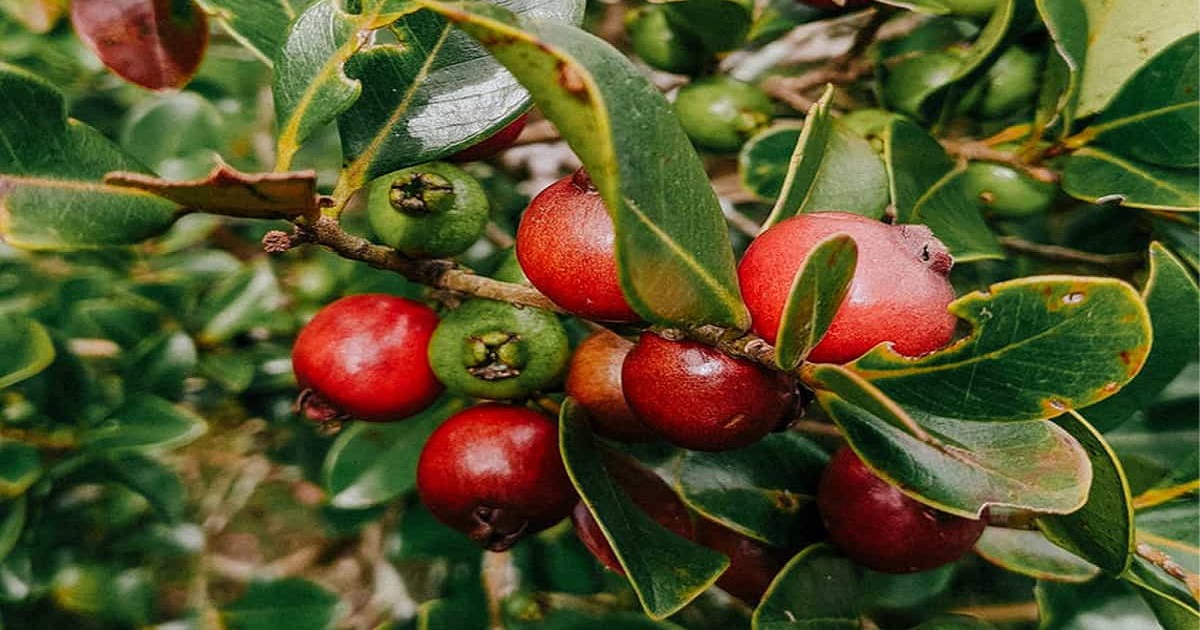Table of Contents
ToggleIntroduction
Strawberry guava, scientifically known as Psidium cattleianum, is a delightful tropical plant celebrated for its luscious fruits and ornamental features. Originating from South America, particularly Brazil and Uruguay, this plant has found its way into gardens and landscapes worldwide due to its adaptability and charming aesthetics.
Characteristics of Strawberry Guava Plant
Physical Description
The strawberry guava plant typically grows as a small tree or shrub, reaching heights of up to 6 meters. It boasts glossy green leaves with a leathery texture, complemented by white, star-shaped flowers that exude a sweet fragrance.
Growth Habit
This plant exhibits a dense and bushy growth habit, making it an excellent choice for hedges or privacy screens in tropical and subtropical regions.
Leaf Structure
The leaves of the strawberry guava plant are oval-shaped, ranging from 3 to 7 centimeters in length, with prominent veins and a glossy surface.
Flower and Fruit
The plant produces small, white flowers with prominent stamens, which eventually give way to round or ovoid fruits measuring approximately 2 to 4 centimeters in diameter. These fruits resemble miniature strawberries, hence the common name “strawberry guava.” They ripen to a vibrant red or yellow color and boast a sweet and tangy flavor reminiscent of a combination of strawberry and guava.
Cultivation of Strawberry Guava Plant
Climate Requirements
Strawberry guava thrives in warm, humid climates with consistent rainfall. It can tolerate occasional drought but prefers well-drained soil and plenty of sunlight.
Soil Conditions
The plant prefers slightly acidic to neutral soil with good drainage. Sandy loam or loamy soil types are ideal for optimal growth.
Planting Procedure
When planting strawberry guava, ensure that the soil is well-prepared and free from weeds. Dig a hole slightly larger than the root ball and place the plant at the same depth as it was in the nursery container. Backfill the hole with soil and water thoroughly to settle the roots.
Maintenance Tips
Regular watering, especially during dry periods, is essential for young plants. Mulching around the base of the plant helps retain moisture and suppress weed growth. Pruning can be done to maintain shape and promote fruit production.
Propagation Methods
Seed Propagation
Strawberry guava seeds can be collected from ripe fruits and sown in seed trays filled with a well-draining potting mix. Keep the trays in a warm, humid environment until germination occurs.
Cutting Propagation
Softwood cuttings taken from healthy, mature plants can be propagated in a moist, sterile potting mix. Provide bottom heat and maintain high humidity to encourage root development.
Grafting Techniques
Grafting onto rootstock of related species such as common guava (Psidium guajava) can be successful in producing vigorous strawberry guava plants with improved disease resistance.
Pruning and Training
Importance of Pruning
Pruning helps maintain the desired size and shape of the plant, improves air circulation, and encourages fruit production by removing dead or diseased branches.
Pruning Techniques
Remove any dead, damaged, or crossing branches using clean, sharp pruning shears. Shape the plant by selectively pruning to promote an open and balanced canopy.
Training for Optimal Growth
Young plants can be trained to a central leader or open vase shape to maximize sunlight penetration and fruit development. Regular training during the first few years helps establish a strong and productive framework.
Pest and Disease Management
Common Pests
Strawberry guava plants may be susceptible to pests such as fruit flies, scale insects, and aphids. Regular monitoring and prompt action are essential to prevent infestations.
Effective Control Measures
Natural predators, such as ladybugs and lacewings, can help control pest populations. Organic insecticidal soaps or horticultural oils may be used to treat severe infestations.
Disease Prevention Strategies
Proper cultural practices, such as adequate spacing between plants and good air circulation, can help prevent fungal diseases such as anthracnose and powdery mildew. Avoid overhead watering to reduce the risk of foliar diseases.
Harvesting and Storage
Ripening Process
Strawberry guava fruits typically ripen 3 to 4 months after flowering. They are ready for harvest when they attain their characteristic color and yield slightly to gentle pressure.
Harvesting Guidelines
Gently twist or cut the ripe fruits from the plant using sanitized pruners. Handle the fruits with care to avoid bruising or damage.
Storage Recommendations
Fresh strawberry guava fruits can be stored in the refrigerator for up to two weeks. They can also be frozen for longer-term storage or processed into jams, jellies, or beverages.
Utilization of Strawberry Guava
Culinary Uses
Strawberry guava fruits are versatile and can be enjoyed fresh or used in various culinary applications, including salads, desserts, and beverages. They add a unique tropical flavor to recipes and are rich in vitamin C and antioxidants.
Medicinal Properties
In traditional medicine, various parts of the strawberry guava plant, including the leaves and fruits, are used for their purported medicinal properties. They are believed to have anti-inflammatory, antimicrobial, and antioxidant effects.
Ornamental Value
Beyond its culinary and medicinal uses, the strawberry guava plant is prized for its ornamental value. It adds visual interest to gardens and landscapes with its evergreen foliage, fragrant flowers, and colorful fruits.
Environmental Impact
Ecological Importance
Strawberry guava plants play a vital role in their native ecosystems, providing food and habitat for native wildlife such as birds and small mammals. However, they can also become invasive in certain regions, outcompeting native vegetation and disrupting natural ecosystems.
Conservation Efforts
Efforts are underway to manage and control invasive populations of strawberry guava in ecologically sensitive areas. These efforts include targeted removal, habitat restoration, and public education initiatives to prevent further spread.
Popular Varieties
‘Beaumont’ Strawberry Guava
This cultivar is prized for its large, flavorful fruits and compact growth habit, making it suitable for small gardens or container cultivation.
‘Yellow Strawberry Guava’
As the name suggests, this variety produces yellow-colored fruits with a slightly sweeter flavor profile than traditional red strawberry guavas.
‘Red Malaysian Guava’
Originating from Malaysia, this variety features vibrant red fruits with a distinctively tart flavor, perfect for culinary use.
Cultural Significance
Traditional Uses
In many cultures, strawberry guava fruits hold cultural and ceremonial significance, often being incorporated into rituals or celebrations.
Festivals and Celebrations
Some regions host festivals or events dedicated to celebrating the strawberry guava plant, showcasing its cultural importance and culinary heritage.
Health Benefits
Nutritional Profile
Strawberry guava fruits are not only delicious but also packed with essential nutrients. They are rich in vitamin C, fiber, and antioxidants, making them a valuable addition to a balanced diet.
Therapeutic Properties
In traditional medicine, strawberry guava leaves are brewed into teas or infusions believed to have medicinal properties. They are often used to alleviate symptoms of digestive disorders, such as diarrhea and dysentery, as well as to promote overall health and well-being.
Future Prospects
Research and Development
Ongoing research into the genetic diversity of strawberry guava plants aims to identify traits for improved fruit quality, disease resistance, and environmental adaptability. This research holds promise for the development of new cultivars with enhanced characteristics.
Commercial Potential
The growing popularity of exotic fruits and the increasing demand for natural and organic products present opportunities for the commercial cultivation of strawberry guava. Small-scale farmers and commercial growers alike can capitalize on this trend by supplying fresh fruits, processed products, and ornamental plants to local and international markets.
Conclusion
Strawberry guava plant, with its captivating beauty and delectable fruits, holds immense potential for both home gardeners and commercial growers. By understanding its characteristics, cultivation requirements, and diverse uses, enthusiasts can appreciate and harness the full potential of this tropical gem.


